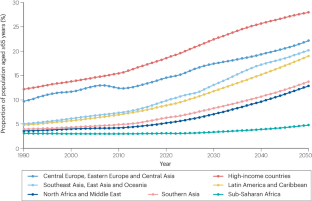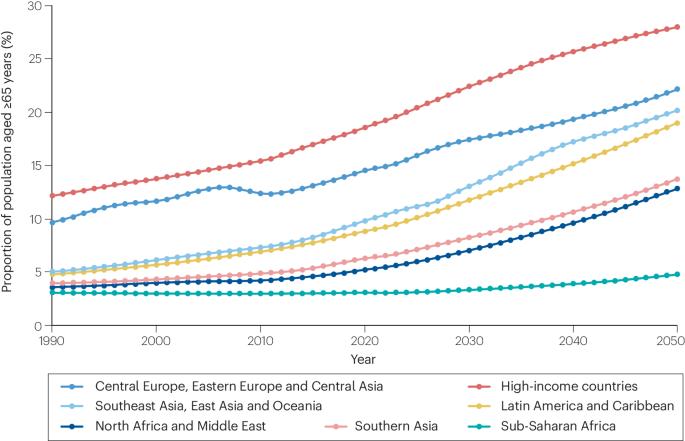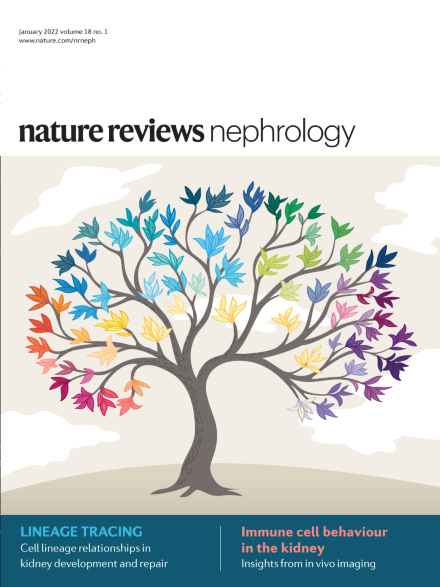人口老龄化对慢性肾病负担的影响。
IF 28.6
1区 医学
Q1 UROLOGY & NEPHROLOGY
引用次数: 0
摘要
随着全球人口迅速老龄化,慢性肾脏病(CKD)及其风险因素的负担预计也将随之增加。到 2050 年,某些地区 G3-G5 类慢性肾脏病的发病率可能超过 10%,从而造成巨大的健康和经济负担,对低收入国家的影响尤为严重。在多大程度上可以缓解慢性肾功能衰竭的流行,很大程度上取决于针对可改变的风险因素所采取的预防措施、为早期发现高危人群的慢性肾功能衰竭而实施的具有成本效益的筛查计划,以及新一代肾脏保护药物的普及和可负担性,以防止慢性肾功能衰竭的发生并延缓其进展。老年患者需要采用多学科综合方法来管理他们的多病、多重药物治疗、不良后果高发、心理健康、疲劳和其他与年龄有关的症状。对于进展到肾衰竭的患者,在共同决策过程中,应将综合保守治疗作为一种可行的选择,以共同确定一种尊重患者价值观和意愿的治疗方法。此外,还应提供维持或改善生活质量的干预措施,包括疼痛管理和适当的姑息治疗服务。本文章由计算机程序翻译,如有差异,请以英文原文为准。


The impact of population ageing on the burden of chronic kidney disease
The burden of chronic kidney disease (CKD) and its risk factors are projected to rise in parallel with the rapidly ageing global population. By 2050, the prevalence of CKD category G3–G5 may exceed 10% in some regions, resulting in substantial health and economic burdens that will disproportionately affect lower-income countries. The extent to which the CKD epidemic can be mitigated depends largely on the uptake of prevention efforts to address modifiable risk factors, the implementation of cost-effective screening programmes for early detection of CKD in high-risk individuals and widespread access and affordability of new-generation kidney-protective drugs to prevent the development and delay the progression of CKD. Older patients require a multidisciplinary integrated approach to manage their multimorbidity, polypharmacy, high rates of adverse outcomes, mental health, fatigue and other age-related symptoms. In those who progress to kidney failure, comprehensive conservative management should be offered as a viable option during the shared decision-making process to collaboratively determine a treatment approach that respects the values and wishes of the patient. Interventions that maintain or improve quality of life, including pain management and palliative care services when appropriate, should also be made available. Here, the authors examine the effect of the rapidly ageing global population on the health and economic burden of chronic kidney disease (CKD). They discuss factors that drive or could mitigate the CKD epidemic and highlight complications and symptoms of CKD that are common among older patients.
求助全文
通过发布文献求助,成功后即可免费获取论文全文。
去求助
来源期刊

Nature Reviews Nephrology
医学-泌尿学与肾脏学
CiteScore
39.00
自引率
1.20%
发文量
127
审稿时长
6-12 weeks
期刊介绍:
Nature Reviews Nephrology aims to be the premier source of reviews and commentaries for the scientific communities it serves.
It strives to publish authoritative, accessible articles.
Articles are enhanced with clearly understandable figures, tables, and other display items.
Nature Reviews Nephrology publishes Research Highlights, News & Views, Comments, Reviews, Perspectives, and Consensus Statements.
The content is relevant to nephrologists and basic science researchers.
The broad scope of the journal ensures that the work reaches the widest possible audience.
 求助内容:
求助内容: 应助结果提醒方式:
应助结果提醒方式:


